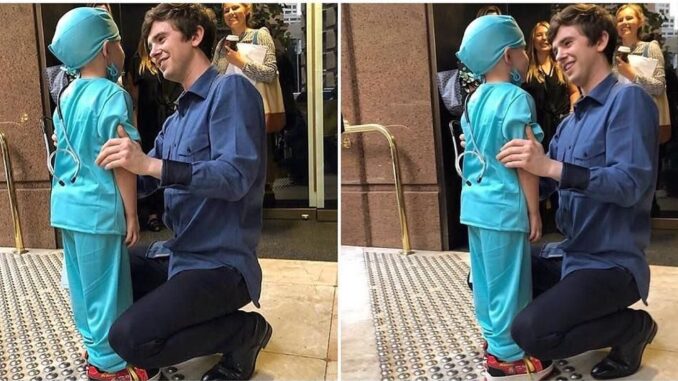
When Tim Burton’s “Charlie and the Chocolate Factory” premiered in the summer of 2005, audiences witnessed a cinematic partnership that would prove formative for both director and young star. For Freddie Highmore, fresh from his heart-wrenching performance in “Finding Neverland,” the role of Charlie Bucket presented a different but equally challenging opportunity: to embody pure-hearted goodness without descending into saccharine sentimentality. Burton’s darkly whimsical reimagining of Roald Dahl’s beloved novel created a perfect showcase for Highmore’s remarkable ability to convey emotional authenticity within fantastical circumstances—a skill that would become his signature as an actor.
The role required Highmore to maintain Charlie’s wide-eyed wonder while navigating the increasingly bizarre and sometimes frightening events of the factory tour. When fellow children are eliminated through various candy-related mishaps, Highmore subtly conveys Charlie’s concern without sanctimony, his fear without cowardice. These nuanced reactions reveal the character’s complexity: Charlie is not a perfect child but a good one, sometimes tempted but ultimately guided by a moral compass formed through family love rather than material advantage.
Perhaps most challenging was Highmore’s task of creating believable chemistry with Johnny Depp’s deliberately unsettling Willy Wonka. Depp’s performance—mannered, twitchy, haunted by childhood trauma—created a character intentionally difficult to connect with. Highmore’s Charlie approaches this strange adult with caution but also with fundamental compassion, recognizing in Wonka’s eccentricity and isolation something that resonates with his own outsider status. Their scenes together showcase Highmore’s remarkable ability to listen and react authentically to his scene partners, a quality that would distinguish his work throughout his career.
The emotional heart of Burton’s adaptation lies in its exploration of father-son relationships—both Charlie’s bond with his struggling but loving father (played by Noah Taylor) and Wonka’s estrangement from his dentist father (Christopher Lee). Highmore navigates these parallel storylines with subtle emotional intelligence, making Charlie’s appreciation of his own impoverished but loving family entirely believable. In the film’s final scenes, as Charlie becomes the catalyst for reconciliation between Wonka and his father, Highmore conveys wisdom beyond his years without sacrificing Charlie’s essential childlike nature.
Working with Burton provided Highmore with a master class in balancing technical precision with emotional truth. Burton’s highly stylized aesthetic demands exact blocking, timing, and visual composition from his actors. Highmore met these technical challenges while maintaining the emotional spontaneity essential to believable character work. This early training in reconciling technical demands with authentic performance would serve him well in later roles that required similar precision, particularly his portrayal of autism in “The Good Doctor.”
The film’s production also exposed Highmore to the possibilities of performance within elaborate fantasy environments. Much of “Charlie and the Chocolate Factory” was filmed against green screens or with practical effects that would be enhanced in post-production. Highmore’s ability to react convincingly to imaginary stimuli—to appear genuinely amazed by chocolate waterfalls or horrified by blueberry transformations that would be added later—demonstrated his exceptional capacity for imaginative engagement, another skill that would distinguish his later work.
The commercial success of “Charlie and the Chocolate Factory”—it grossed over $475 million worldwide—established Highmore as one of the most sought-after child actors of his generation. Yet rather than capitalizing on this momentum to pursue similar roles in big-budget productions, Highmore made the unusual choice to balance his film career with normal education, eventually attending Cambridge University to study Arabic and Spanish. This decision reflects the same thoughtfulness and long-term perspective that have characterized his artistic choices throughout his career.
When viewed in the context of Highmore’s subsequent work, “Charlie and the Chocolate Factory” stands as a pivotal experience that helped shape his artistic identity. The film’s exploration of childhood innocence confronted with adult complexity, its juxtaposition of wonder and darkness, and its interest in the psychological dimensions of fantasy all find echoes in Highmore’s later roles. From Norman Bates’s fractured psyche in “Bates Motel” to Shaun Murphy’s unique perception in “The Good Doctor,” Highmore has consistently portrayed characters whose inner landscapes are richer and more complex than their outward appearances suggest.
Perhaps most significantly, “Charlie and the Chocolate Factory” established Highmore’s characteristic approach to goodness on screen. Throughout his career, he has never shied away from portraying fundamentally decent characters, finding in their moral struggles a complexity as interesting as any villain’s machinations. Charlie Bucket—poor but generous, tempted but steadfast, ordinary yet exceptional—established a template for the kind of nuanced goodness Highmore would later bring to Dr. Shaun Murphy, a character whose different way of experiencing the world never diminishes his fundamental compassion and ethical clarity.

